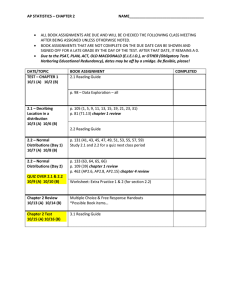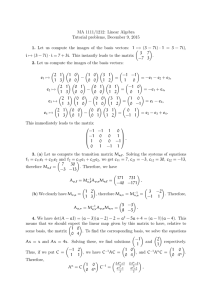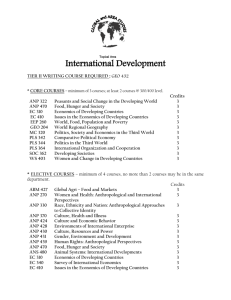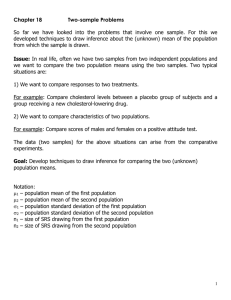Document 11233265
advertisement
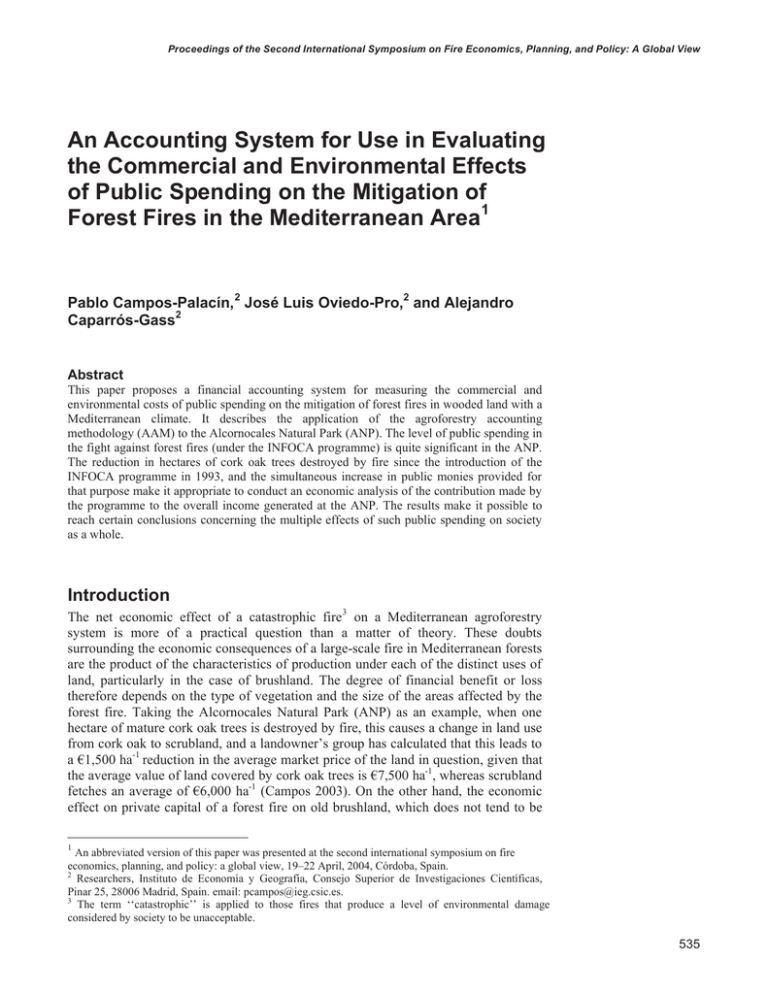
Proceedings of the Second International Symposium on Fire Economics, Planning, and Policy: A Global View An Accounting System for Use in Evaluating the Commercial and Environmental Effects of Public Spending on the Mitigation of Forest Fires in the Mediterranean Area1 Pablo Campos-Palacín, 2 José Luis Oviedo-Pro,2 and Alejandro Caparrós-Gass2 Abstract This paper proposes a financial accounting system for measuring the commercial and environmental costs of public spending on the mitigation of forest fires in wooded land with a Mediterranean climate. It describes the application of the agroforestry accounting methodology (AAM) to the Alcornocales Natural Park (ANP). The level of public spending in the fight against forest fires (under the INFOCA programme) is quite significant in the ANP. The reduction in hectares of cork oak trees destroyed by fire since the introduction of the INFOCA programme in 1993, and the simultaneous increase in public monies provided for that purpose make it appropriate to conduct an economic analysis of the contribution made by the programme to the overall income generated at the ANP. The results make it possible to reach certain conclusions concerning the multiple effects of such public spending on society as a whole. Introduction The net economic effect of a catastrophic fire3 on a Mediterranean agroforestry system is more of a practical question than a matter of theory. These doubts surrounding the economic consequences of a large-scale fire in Mediterranean forests are the product of the characteristics of production under each of the distinct uses of land, particularly in the case of brushland. The degree of financial benefit or loss therefore depends on the type of vegetation and the size of the areas affected by the forest fire. Taking the Alcornocales Natural Park (ANP) as an example, when one hectare of mature cork oak trees is destroyed by fire, this causes a change in land use from cork oak to scrubland, and a landowner’s group has calculated that this leads to a €1,500 ha-1 reduction in the average market price of the land in question, given that the average value of land covered by cork oak trees is €7,500 ha-1, whereas scrubland fetches an average of €6,000 ha-1 (Campos 2003). On the other hand, the economic effect on private capital of a forest fire on old brushland, which does not tend to be 1 An abbreviated version of this paper was presented at the second international symposium on fire economics, planning, and policy: a global view, 19–22 April, 2004, Córdoba, Spain. 2 Researchers, Instituto de Economía y Geografía, Consejo Superior de Investigaciones Científicas, Pinar 25, 28006 Madrid, Spain. email: pcampos@ieg.csic.es. 3 The term ‘‘catastrophic’’ is applied to those fires that produce a level of environmental damage considered by society to be unacceptable. 535 USDA Forest Service Gen. Tech. Rep. PSW-GTR-xxx. xxxx. GENERAL TECHNICAL REPORT PSW-GTR-208 Session 3A— An accounting system for the evaluation —Campos, Oviedo, Caparrós grazed, can actually increase the quantity of forage units consumed by grazing livestock. Nevertheless, before proceeding to evaluate the economic loss or benefit caused by forest fires, it is possible to develop a theoretical accounting structure for forest fires which identifies and evaluates the total economic damage which is expected to be avoided based on the cost of efforts to control forest fires. The accounting theory employed is based on the Hicksian concept of income (Caparrós and others 2003) and total economic value (Campos 1999). The natural environment studied for this purpose is the Alcornocales Natural Park (ANP). The park has 82,462 hectares of cork oak land, which represents 48.5 percent of the Park’s total surface area (table 1). Other tree species cover a further 13,262 hectares within the ANP, and the total wooded surface area therefore represents 56 percent of the total surface area of the entire ANP (Campos 2002). Table 1 – Land uses and principal vegetation types in the ANP Type Cork oak Gall Oak Wild Olive Replanted Brushwood Grassland Arable Other Total Surface (ha) 82,462 6,291 3,060 3,911 38,766 26,694 5,441 3,400 170,025 Percentage (pct) 48.5 3.7 1.8 2.3 22.8 15.7 3.2 2.0 100.0 Source: Campos (2002). Trees and brushwood cover 134,490 ha of the ANP, representing 79 percent of the total (table 1). In particular, the 38,766 ha of brushwood is the type of forest fuel which has all the necessary characteristics for spreading the first flames of any forest fire if human activity does not intervene to prevent it. It is believed that the ANP’s human inhabitants have prevented the propagation of natural forest fires at least since the late 18th century and have used prescribed burning until a few decades ago as a means of productively managing the brushwood in order to produce grazing for their animals. Today, however, prescribed burning is only authorised by Government environment services in order to remove the organic debris created by cork oak forestry activities. Expenditure by private land owners in the fight against forest fires was not considered in this study. The public funds directly employed in the fight against forest fires are overseen by INFOCA programme. The views of owners and visitors in recent contingent valuation surveys show that the ANP’s environmental services are highly valued (Campos 2003, Campos et al. 2003). The Andalusia environment service’s determined policy to prevent catastrophic forest fires in the ANP is only partly justified from an economic perspective. Although the autochthonous flora and fauna in the ANP have survived cyclical catastrophic natural fires in the past 4 , public perception of a catastrophic 4 Only 1 percent of forest fires in the ANP have a natural cause, which indicates that if there had recently been an increase in the frequency and effects of fires in the ANP, it might be expected that there would be greater chances of irreversible environmental effects in the present than in the past. 536 USDA Forest Service Gen. Tech. Rep. PSW-GTR-xxx. xxxx. Proceedings of the Second International Symposium on Fire Economics, Planning, and Policy: A Global View Session 3A— An accounting system for the evaluation —Campos, Oviedo, Caparrós forest fire is now more dramatic, and the Andalusia authorities have responded to this by ploughing funds into fire extinction measures under the INFOCA programme to such an extent that the risk of a forest fire growing into a catastrophic fire has been practically reduced to zero. If public spending on fighting forest fires were required to be economically efficient, both commercially and environmentally – it would be necessary to compare the additional gains and losses obtained by increasing or reducing public spending by a specific amount. It is thought that such a policy would be unacceptable to the groups with an interest in preserving the cork oak trees if it implied contemplating a high risk of catastrophic fire in the name of improving economic efficiency. In other words, the INFOCA programme acts as if a catastrophic fire would create an irreversible situation, in which case the relevant criteria is whether the cost of preventing the damage caused by a fire is acceptable to society. Where there is a perception of an irreversible situation, it is the precautionary principle which rules in public policy concerning forest fires. This paper aims to present the annual economic performance of the INFOCA programme measured by means of accounting system based on the theory of national income. It was considered that the most appropriate approach would be to present the results from one single year, while simulating that the level of public spending and future prices has stabilised. The following analysis identifies and classifies both the output and costs of public spending under the INFOCA programme in 2002 as viewed by national accounting methods. It also provides an estimate of the direct business income generated by the INFOCA programme, a minimum threshold for the amount of loss avoided in order to make the INFOCA programme economically viable and, finally, it discusses whether the INFOCA programme’s strategy of focusing its efforts on suppressing fires could be redirected towards measures to intervene directly by committing increased public spending to preventative work in the National Park. Methodology An economic analysis of the direct effects of public spending under the INFOCA programme on the ANP’s total social income requires a standardised local system of economic accounts for agro-forestry (EAAF) which makes it possible to present the data in a clear and objective manner which is comparable with the aggregate figures obtained from national accounts (Campos 1999, 2002). The concepts of production and business costs employed in this paper are defined in the European System of Accounts (ESA95) (Commission 1996). Total sustainable social income (TSI) generated in a certain period in one single area is obtained from the sum of the total net value added (NVA) and the value of capital gains (CG) obtained during the accounting period in the area in question. The lack of standardised national accounts which take into account both elements of the TSI make it necessary to employ the methodology applied in the EAAF system, which was developed in order to incorporate commercial and environmental values under the same criteria as national accounts, but extended to the environmental values and the capital balance account (Campos 1999, Campos and others 2001, Caparrós and others 2003). Applying this system to the INFOCA programme distinguishes between two sets of accounts, i.e. production and fixed capital. 537 GENERAL TECHNICAL REPORT PSW-GTR-208 Session 3A— An accounting system for the evaluation —Campos, Oviedo, Caparrós The INFOCA programme contributes to the ANP’s economy through the production accounts by means of four activities (prevention, surveillance, extinction and health services) which imply a total direct cost for the government environmental services (GES). The total cost (TC) of any activity under the INFOCA programme is broken down into intermediate consumption (IC) of raw materials (RM) and services (SS), salaried labour (SL) and consumption of fixed capital (CFC) . Total production (TP) generated is classified either as intermediate production (IP) or final production (FP). The private companies whose activities are funded by public5 spending obtain a net operating margin through payment for the services of capital they have invested, but no margin is contemplated where the GES undertakes the activity itself (table 2). The assumption that prices and investment volume are not subject to variation, as well as the absence of catastrophic destruction, means that capital gains for the four activities under the INFOCA programme are zero (tables 2 and 3). The attributable additional total cost of the remaining economic activities (RAs) carried out in the ANP, i.e. what remains after excluding the four above-mentioned activities in the INFOCA programme, is, as a result of the programme, the intermediate consumption of internal services and the aggregate annual sum of the long-standing amortizations of the clearance of brushwood yet to be amortized. . It is this additional total cost, equivalent to the total production of the four INFOCA programme activities, which makes it possible to avoid the additional loss of income 6 which would result in the ANP’s remaining economic activities (RA) if the cost did not exist. The INFOCA programme may therefore be considered responsible for generating an additional total production, an additional net margin and an additional capital gain in the ANP’s remaining economic activities. The sum of this additional net margin and capital gain is the additional total capital income of the RAs 7 generated by the INFOCA programme. In other words, this additional capital income represents the loss prevented by the INFOCA programme. The additional total social income produced by the INFOCA programme over the whole of the ANP is obtained by aggregating the net added value from the INFOCA programme activities and the additional capital income arising in the RA due to the INFOCA programme. All values are known, except the additional total production (TPra) and additional capital gains (CGra) earned by all the RAs undertaken in the ANP. The beneficiaries of the ANP’s additional total social income generated through the INFOCA programme are the private land owners, the public who visit the Park and passive users who benefit from the welfare derived from the conservation of the cork oak habitat and the other environmental functions, whose consumers are impossible to identify. These passive users can be grouped under the heading ‘society as a whole’. 5 It is assumed that the consumption of capital for the own-account production of fixed capital goods is zero, except for brushwood clearing, in which respect it is considered that the government environmental service’s investment in infrastructure is permanent, given that it is adequately maintained. 6 It is assumed that all the previous amortization achieved through preventive clearance of brushwood in the years prior to 2002 is valued at replacement cost, thereby equalling the values of the previous amortization and the investment in 2002. 7 It is assumed that the INFOCA programme does not give rise to additional private costs in the ANP’s remaining activities, or, in other words, if the INFOCA programme were to be terminated, the current private costs of the RAs would not be reduced. 538 USDA Forest Service Gen. Tech. Rep. PSW-GTR-xxx. xxxx. 3.10 3.10 0.00 3.02 0.24 0.00 0.24 0.24 0.00 2.78 0.08 2.86 0.00 0.08 2.86 0.00 6.13 0.09 6.22 0.00 0.09 6.22 Surveillance (2) 7.09 0.00 7.09 7.00 0.87 0.06 0.81 0.81 Prevention (1) 0.00 20.09 0.27 20.36 0.00 0.27 20.36 25.07 25.07 0.00 24.80 4.71 0.77 3.94 3.94 Extinction (3) 0.00 0.23 0.01 0.24 0.00 0.01 0.24 0.30 0.30 0.00 0.29 0.06 0.01 0.05 0.05 Health services (4) 0.00 29.23 0.45 29.68 0.00 0.45 29.68 35.56 28.47 7.09 35.11 5.88 0.84 5.04 5.04 INFOCA (5=1+2+3+4) 28.47 7.09 0.00 TPra–35.56 TPa–35.56 CGra TPra+CGra–35.56 TPra+CGra–35.56 TPra IPra FPra 35.56 28.47 0.00 28.47 Additional effect in remaining activities (6) TPra+35.56 IPra+28.47 FPra+7.09 70.67 34.35 0.84 33.51 5.04 28.47 7.09 29.23 TPra–35.11 TPra–5.88 CGra TPra+CGra–35.11 TPra+CGra–5.88 Total additional effect (7=5+6) USDA Forest Service Gen. Tech. Rep. PSW-GTR-xxx. xxxx. Source: Own work based on data supplied by EGMASA, FAASA, CMA and officials at the Centro de Defensa Forestal at Alcalá de los Gazules (CEDEFO Alcalá) AWB: area of woodland and brushwood in the Alcornocales Natural Park (134.490 ha) 1 1 Total additional production (TP) 1.1 Intermediate production (IP) 1.2 Final production (FP) 2 Total cost (TC) 2.1 Intermediate consumption (IC) 2.1.1 Raw materials (RM) 2.1.2 Services (SS) External services (SSe) Internal services (SSi) 2.2 Consumption of fixed capital (CFC) 2.3 Labour (M) 3 Net operating margin (NOM = TP – TC) 4. Net added value (NAV = M + NOM) 5 Capital gains (CG) 6 Additional capital income (CI = CG + NOM) 7 Total additional social income (TSI = M + CI) Type Table 2 – Production accounts for the INFOCA programme in the ANP for 2002. (€ ha-1 of the AWB1) Session 3A— An accounting system for the evaluation —Campos, Oviedo, Caparrós Proceedings of the Second International Symposium on Fire Economics, Planning, and Policy: A Global View 539 GENERAL TECHNICAL REPORT PSW-GTR-208 Session 3A— An accounting system for the evaluation —Campos, Oviedo, Caparrós Table 3 – Fixed capital balance sheet for the INFOCA programme in the ANP in 2002 (€ ha–1 of AWB1) Type Initial fixed capital (FCi) Internal investment FCii) External investment (FCei) Outflow fixed capital (FCo) Final fixed capital (FCf) Appreciation (FCa)2 1 2 Water points 0.32 Buildings Brushwand ood towers clearings 18.70 31.25 Fire extinction vehicles 3.49 Communica -tion equipment 0.77 7.09 0.32 0.00 18.70 0.00 31.25 -7.09 Total 54.43 7.09 3.49 0.00 0.77 0.00 54.43 -7.09 AWB: area of woodland and brushwood in the Alcornocales Natural Park (134.490 ha) FCr = FCf + FCs – FCi – FCii – FCie. Source: Own work based on data supplied by EGMASA, FAASA and CMA. The effects of public spending on the INFOCA programme therefore manifest themselves, on the one hand, by generating direct income from labour and the net operating margins of the business contracted to carry out the work and, on the other, in the income obtained by the ANP’s remaining production 8 . The importance of the consumption of environmental services in the Park is readily highlighted by the previously unpublished results of two contingent valuation surveys conducted among the individual private landowners and the recreational visitors who have free access to the park. The willingness of private landowners to pay (WtP) for the environmental services they have themselves consumed is ‘levied’ in its totality by the market, via payment of its capital value upon sale of the estate (Campos 2003). When comparing the value of the environmental services reported by visitors to the ANP and the level of public spending, it is necessary to ascertain precisely which part of the surplus reported by the consumer could be recovered in the event of establishing charges for recreational visits and a habitat conservation fund (Caparrós and Campos 2002). The environmental value of the ANP to its passive users, called the conservation value for ‘society as a whole’, is not currently known. Economic performance of the INFOCA Programme The information analysed by the authors concerning public spending on fire fighting and prevention in the ANP, cost them a great deal of effort making enquiries and conducting searches at various offices at the Andalusia government environmental service and among the contractors engaged in carrying out the work envisaged under the INFOCA programme in the ANP. The geographical areas covered by the 8 Given that none of the three above-mentioned groups which benefit from public spending under the INFOCA programme interiorise the payment in the form of intermediate consumption of the intermediate production of services, their respective appropriate capital incomes are overvalued by an amount equal to the value of the intermediate production of services by public spending under the INFOCA programme. 540 USDA Forest Service Gen. Tech. Rep. PSW-GTR-xxx. xxxx. Proceedings of the Second International Symposium on Fire Economics, Planning, and Policy: A Global View Session 3A— An accounting system for the evaluation —Campos, Oviedo, Caparrós government bodies and the contractors mentioned above regularly extend beyond the limits of the ANP. In certain cases such as the aerial fumigation company Fumigación Aérea Andaluza S.A. (FAASA), spending is based on the whole of Andalusia, and the costs attributed to the ANP are therefore solely an estimate obtained from a calculation based on the surface area of woodland and brushwood (AWB). It is assumed that all spending by the Provincial Operations Centre at Cadiz is allocated to the ANP, given that the Park is its principal zone of operations 9 . The INFOCA programme is implemented by public servants and also the private sector. The principal public body is the Andalusia Government’s Environment Department (ED), which co-ordinates the INFOCA programme through its Provincial Operations Centres (POC). The POC with which the ANP has most contact is the centre in Cadiz. The POC is staffed by a Director and Deputy Director of the INFOCA programme in Cadiz, the fire extinction team and other specialised officers. The ED directly controls a limited company called Gestión Medio Ambiental S.A. (EGMASA), which handles the hiring and administration of the workforce employed under the INFOCA programme, as well as the acquisition and administration of vehicles for this workforce. The aeroplanes and helicopters are hired directly by the ED from the contractor FAASA. Table 4 displays the average number of hectares of wooded and non-wooded areas burnt in two distinct periods, namely, the period between 1980 and 1992, when the average annual area destroyed by fire represented 0.62% of the total wooded area of the ANP, and the period under the INFOCA programme (1993-2002), during which time the average annual area destroyed by fire represented 0.4% of the total wooded area. Since its inception, the INFOCA programme has resulted in a 35% reduction in the average area destroyed by fire per year. Table 4 – Average wooded and non-wooded surface area burnt in the ANP in the periods from 1980 to 1992 and 1993 to 2002 (ha). Period 1980-1992 1993-2002 Wooded surface area 593.40 383.16 Non-wooded surface area 662.34 276.99 Total forest area 1,255.74 660.15 Source: Own work based on data supplied by the Cadiz Provincial Operations Centre Eighty percent of the total production of the INFOCA programme’s four activities is derived from the intermediate production of services, the remaining twenty percent of direct production under the INFOCA programme being supplied by the final production of internal investment. The total direct cost of these activities is divided into eighty-three percent for labour and seventeen percent for intermediate consumption (table 2). Table 2 allows us to provide an estimate of 29.68 € ha-1 of AWB for the direct net added value of the INFOCA programme in the ANP in 2002. This demonstrates 9 Any subjective criteria adopted in order to govern the distribution of spending under the INFOCA programme is, to a greater or lesser degree, open to criticism. It might, on the one hand, be argued that the INFOCA programme would not exist without an area covered by woodland trees, or, at least, that public spending on fighting brushwood fires would be minimal. On the other hand, it could be argued that it is the very presence of wooded and non-wooded areas of brushwood which is the real cause behind the spread of small fires into catastrophic forest fires. USDA Forest Service Gen. Tech. Rep. PSW-GTR-xxx. xxxx. 541 GENERAL TECHNICAL REPORT PSW-GTR-208 Session 3A— An accounting system for the evaluation —Campos, Oviedo, Caparrós that almost the entire direct income thus generated is employed in financing labour costs. It would be helpful in evaluating the INFOCA programme if a minimum threshold could be established for the required for additional social capital income which must be generated by the whole of the remaining activities in the ANP to ensure that public spending on fire prevention and suppression reaches a specific required level of social profitability. In the hypothetical and highly unlikely case that the government environmental services were to decide that one aim of the INFOCA programme was to be that its annual investment should reach a real social profitability rate of 2.5 percent (Pearce and Ulph 1995), the question would then be what is the minimum value of additional capital income – the minimum value of avoided loss – which must be provided by the RA in order to achieve a social profitability rate of 2.5 percent in 2002? Fixed assets (FA 10 ) in the INFOCA programme in the ANP amounts to 72 € ha-1. In order for this annual investment to reach a real social profitability rate of 2.5 percent, the additional capital income (CIa) obtained by this investment must reach a minimum annual value of 1.8 € ha-1 of AWB. In other words, the minimum additional total production and capital gains obtained by the landowners, visitors and society as a whole under the INFOCA programme must reach an annual figure of 36.91 € ha-1 of AWB: CI = (0.45 – 28.47 – 7.09) € ha-1 + TPra + CGra t 1.8 € ha-1, Cy = TPra + CGra – 35.11 t 1.8 € ha-1, TPra + CGra t 36.91 € ha-1 of AWB. The additional total social income (TSIa) generated by the INFOCA programme was not measured in this study. The identity which would make it possible to obtain the INFOCA programme’s TSIa in the ANP is as follows (table 2): TSI = TPra + CGra – 5.88. It would be necessary to evaluate the additional annual gain for commercial and environmental values in the ANP represented by TPra and CGra in order to obtain a correct figure for the income gained or loss avoided through the INFOCA programme. However, doing so would imply ascertaining the level of TSI which would be attained in the absence of the INFOCA programme. At the present time, any figure given in this respect would be no more than a hypothetical estimate. Discussion If one accepts the postulate that loss through catastrophic fire is perceived as irreversible, the issue enjoying the greatest priority is not an evaluation of the additional income gained, but rather the level of public spending needed to prevent the loss, provided the spending levels do not reach a figure which society considers to be high. In the absence of an evaluation of the loss prevented by the INFOCA programme, provisional figures are offered for the value of the income from the environmental services consumed by the landowners and members of the public visiting the ANP which could be lost to a great extent due to repeated catastrophic fires. 10 542 Fixed assets represent the mean value of the capital employed throughout 2002 in the INFOCA programme. The identity employed to obtain this value is: FA = FCi + 0.5 TCd. USDA Forest Service Gen. Tech. Rep. PSW-GTR-xxx. xxxx. Proceedings of the Second International Symposium on Fire Economics, Planning, and Policy: A Global View Session 3A— An accounting system for the evaluation —Campos, Oviedo, Caparrós With respect to private environmental services, the amount of environmental income which has been self-consumed by the private individual landowners might have reached an average value of €208 ha-1 year-1 in 2002 (Campos 2003). The as yet small number of visitors to the ANP attributes a notably lower value to the public environmental services than the private landowners. The visitors’ median (mean) willingness to pay (WtP) is estimated at €22.2 for the enjoyment obtained from a visit to the ANP, and the average visitor is willing to contribute an annual sum of €13.8 to a conservation fund for the ANP (Campos et al. 2003). If it is accepted that the median (mean) WTP would only be paid by half the visitors – it has been estimated that the ANP received 0.47 visits per hectare of total surface area in 2002 – the introduction of a compulsory charge for their consumption of environmental services would generate €11.82 ha-1 year-1 (Campos et al. 2003). The aggregate value achieved by the capital income from both types of environmental services amounts to €219.82 ha-1 in the ANP, and it may therefore be stated that there is evidence that the value of the economic loss prevented by the INFOCA programme in the ANP is significant, without knowing whether or not it reaches the €36.91 ha-1 threshold required by a social profitability rate of 2.5 percent. If the private landowners were to be responsible themselves for public spending under the INFOCA programme, the private sector net operating margin would decrease as part of the current level of public spending under the programme in order to maintain the current low levels of risk with respect to catastrophic fire. It seems unlikely that the landowners would be happy to accept such a situation, nor would it perhaps be desirable for society as a whole, given the sizeable presence of the public environmental services. It is perhaps the case that the only means of ensuring that the risk of a catastrophic fire in the ANP will continue to be as close as it is to zero is adequate public spending at present levels. Nevertheless, it is debatable whether spending during the INFOCA has been distributed in the most effective way, as the emphasis is on reaching the fire in the shortest possible time, as demonstrated by the limited spending under the INFOCA programme on prevention in 2002, which took up twenty percent of spending compared to the seventy percent spent on fire extinction activities (table 2). Conclusion Forest fire fighting activities in the ANP are principally characterised by public spending. Government agencies have delegated the execution of the preventive measures to the private landowners, and it would appear that the subsidies offered for implementing such treatments have not gained sufficient prominence. This paper has presented a measure of the direct economic effect of public spending on forest fires in the ANP. The results suggest that the public bodies’ success with the INFOCA programme has been considerable, if the programme is measured by the reduction in the number of hectares burnt in the last decade. The philosophy behind the INFOCA programme continues to place the emphasis on its strategy of extinguishing fires through the provision of sufficient funding in order to achieve this aim, but without applying any criteria of economic efficiency. The strategy would seem to draw its strength from public opinion, which has shown it to be benevolent towards public spending aimed at protecting a natural or environmental resource. 543 GENERAL TECHNICAL REPORT PSW-GTR-208 Session 3A— An accounting system for the evaluation —Campos, Oviedo, Caparrós Acknowledgements The study of public spending under the INFOCA programme was financed by the research project set up by the European Union’s Fifth Framework Programme, Tools for evaluating investment in the Mediterranean mountain areas-An integrated framework for sustainable development (MEDMONT) (QLRT-1999-31031). The contingent valuation survey of the landowners was financed by the Ministry of Science and Technology’s National R&D Plan, Economy and Silviculture of Cork Oak Woodland (ECOSEAL) (AGL2000-0936-C02-02). Finance for the contingent valuation survey of the free-access recreational visitors to the ANP was provided by the Andalusia Government’s Environment Department. A great number of people and businesses have provided information voluntarily to make this paper possible. Some, such as José Antonio González Gutiérrez (Deputy-Director of the INFOCA programme in the Province of Cadiz) and Felipe Oliveros Pruaño (DirectorConservationist at the Alcornocales Natural Park), have helped to improve this paper by providing their opinions throughout the study. The authors’ acknowledgment of the people and institutions cited above in no way implies that they are in any way responsible for the data and views presented in this paper, for which sole responsibility lies with the authors. References Campos, P., 1999. Hacia la medición de la renta de bienestar del uso múltiple de un bosque. Investigación Agraria: Sistemas y Recursos Forestales, Vol. 8(2): 407-422. Campos, P.; Rodríguez, Y.; and Caparrós, A., 2001. Towards the Dehesa total income accounting: theory and operative Monfragüe study cases. Investigación Agraria: Sistemas y Recursos Forestales, número fuera de serie, 1: 45-69. Campos, P., 2002. Economía del uso múltiple del bosque: Montes Propios de Jerez de la Frontera (1991-1993). Revista Española de Estudios Agrosociales y Pesqueros, Volumen 195: 147 – 186. Campos, P., 2003. Autoconsumo de servicios ambientales privados en el Parque Natural de los Alcornocales. Provisional report. IEG-CSIC. Internal working paper. Campos, P., Caparrós, A. and Oviedo, J.L., 2003. Uso recreativo y de conservación en el Parque Natural de los Alcornocales. Informe provisional. Convenio Instituto de Economía y Geografía del Consejo Superior de Investigaciones Científicas y la Consejería de Medio Ambiente de la Junta de Andalucía. Internal working paper. Caparrós, A. and Campos, P., 2002. Valoración de los usos recreativo y paisajístico en los pinares de la sierra de Guadarrama. Revista Española de Estudios Agrosociales y Pesqueros, 195: 121-146. Caparrós, A., Campos, P. and Montero, G., 2003. An Operative Framework for Total Hicksian Income Measurement: Application to a Multiple Use Forest. Environmental and Resource Economics, 26: 173-198. Commission of the European Communities, 1996. European system of accounts (ESA 95). Eurostat, Luxemburgo. Pearce, D. and Ulph, D. (1995) A social discount rate for the United Kingdom. CSERGE. Working Paper GEC 95-01, Norwich. 544 USDA Forest Service Gen. Tech. Rep. PSW-GTR-xxx. xxxx.
